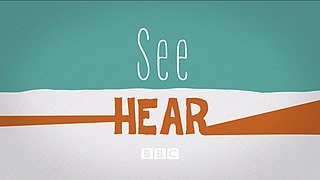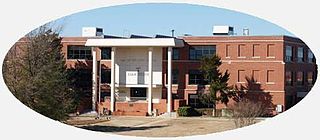
Gallaudet University is a private federally chartered research university in Washington, D.C., for the education of the deaf and hard of hearing. It was founded in 1864 as a grammar school for both deaf and blind children. It was the first school for the advanced education of the deaf and hard of hearing in the world and remains the only higher education institution in which all programs and services are specifically designed to accommodate deaf and hard of hearing students. Hearing students are admitted to the graduate school and a small number are also admitted as undergraduates each year. The university was named after Thomas Hopkins Gallaudet, a notable figure in the advancement of deaf education.
Martha's Vineyard Sign Language (MVSL) was a village sign-language that was once widely used on the island of Martha's Vineyard from the early 18th century to 1952. It was used by both deaf and hearing people in the community; consequently, deafness was not a barrier to participation in public life. Deaf people who signed Martha's Vineyard Sign Language were extremely independent.

See Hear is a monthly magazine programme for deaf and hard-of-hearing people in the United Kingdom, broadcast on Wednesday mornings at 8.00am. The programme focuses on the British and the worldwide deaf community and covers a broad range of topics from areas such as education, deaf people's rights, technology and language. The programme is presented entirely in BSL and is broadcast with voice-over and subtitles in English. This allows both deaf and hearing people to understand the programme. See Hear is currently the fifth longest-running BBC programme.

The Royal National Institute for Deaf People (RNID), known as Action on Hearing Loss from 2011 to 2020, is a charitable organization working on behalf of the UK's 9 million people who are deaf or have hearing loss.
Flemish Sign Language is a deaf sign language of Belgium. It is closely related to French Belgian Sign Language, but they are now generally recognized as distinct languages. VGT is estimated to include around 6,000 sign-language users.

Oklahoma School for the Deaf (OSD) is a public residential school for the deaf and hard of hearing students ages 2 through 18. The school teaches K-12 students in Sulphur, Oklahoma, United States.
The South Dakota Services for the Deaf (SDSD) is a state agency that supports deaf children in South Dakota. Formerly it was a state-supported school located in Sioux Falls, South Dakota that provided services to meet the educational needs of children who are deaf, hard-of-hearing, or have cochlear implants. SDSD is governed by the South Dakota Board of Regents.

The North Dakota School for the Deaf (NDSD) is a state-funded residential school located in Devils Lake, North Dakota that provides services to meet the educational needs of children who are deaf and hard of hearing. NDSD is under the direction, control, and management of the North Dakota Department of Public Instruction. The current superintendent of the school is Dr. Connie Hovendick.
Communication Service for the Deaf (CSD) is a global social impact organization founded in 1975 by Benjamin Soukup. CSD provides technologies, resources, and services that benefit the deaf and hard-of-hearing community.

The Minnesota State Academy for the Deaf (MSAD) is a public residential school serving deaf children in Minnesota, United States. It is one of two Minnesota State Academies in Faribault and operated by the state for particular student populations.
Sertoma Inc., formerly known as Sertoma International, is an organization of service clubs founded on April 11, 1912. The name is an acronym for Service toMankind. Sertoma has clubs all over the United States and in Canada. Sertoma's primary focus is on assisting the more than 50 million people with hearing health issues and educating the public on the issues surrounding hearing health. In order to achieve these goals, Sertoma has undertaken a multi-faceted approach by launching programs that address both the treatment and prevention aspects of hearing health.
In the United States, deaf culture was born in Connecticut in 1817 at the American School for the Deaf, when a deaf teacher from France, Laurent Clerc, was recruited by Thomas Gallaudet to help found the new institution. Under the guidance and instruction of Clerc in language and ways of living, deaf American students began to evolve their own strategies for communication and for living, which became the kernel for the development of American Deaf culture.
The Wyoming School for the Deaf was a school for deaf elementary students located in Casper, Wyoming, United States. The school was open from 1961 until it was closed due to a lack of students in 2000. The school was created to accommodate the concerns of parents who did not want to send their deaf children to schools in other states. Early pilot programs were conducted, and in 1959, a house was purchased across from the local Pineview Elementary School and used to house the program. In 1961, the state legislature appropriated more funds for the program and a permanent school was built and dedicated in 1963.

Deaf education is the education of students with any degree of hearing loss or deafness. This may involve, but does not always, individually-planned, systematically-monitored teaching methods, adaptive materials, accessible settings, and other interventions designed to help students achieve a higher level of self-sufficiency and success in the school and community than they would achieve with a typical classroom education. There are different language modalities used in educational setting where students get varied communication methods. A number of countries focus on training teachers to teach deaf students with a variety of approaches and have organizations to aid deaf students.
The history of deaf education in the United States began in the early 1800s when the Cobbs School of Virginia, an oral school, was established by William Bolling and John Braidwood, and the Connecticut Asylum for the Deaf and Dumb, a manual school, was established by Thomas Hopkins Gallaudet and Laurent Clerc. When the Cobbs School closed in 1816, the manual method, which used American Sign Language, became commonplace in deaf schools for most of the remainder of the century. In the late 1800s, schools began to use the oral method, which only allowed the use of speech, as opposed to the manual method previously in place. Students caught using sign language in oral programs were often punished. The oral method was used for many years until sign language instruction gradually began to come back into deaf education.

The Deaf rights movement encompasses a series of social movements within the disability rights and cultural diversity movements that encourages deaf and hard of hearing to push society to adopt a position of equal respect for them. Acknowledging that those who were Deaf or hard of hearing had rights to obtain the same things as those hearing lead this movement. Establishing an educational system to teach those with Deafness was one of the first accomplishments of this movement. Sign language, as well as cochlear implants, has also had an extensive impact on the Deaf community. These have all been aspects that have paved the way for those with Deafness, which began with the Deaf Rights movement.
Kendall Demonstration Elementary School (KDES) is a private day school serving deaf and hard of hearing students from birth through grade 8 on the campus of Gallaudet University in the Trinidad neighborhood of Washington, D.C. Alongside Model Secondary School for the Deaf, it is a federally funded, tuition-free demonstration school administered by the Laurent Clerc National Deaf Education Center at Gallaudet University.
A large deaf community exists in Frederick County, Maryland partly due to the Maryland School for the Deaf, the county's proximity to Gallaudet University in Washington, D.C., and a large number of government jobs. One estimate suggests that as many as 50,000 people in Frederick County and the surrounding area may be deaf or hard of hearing, and that 3,000 people in the city of Frederick may be deaf or hard of hearing. A 2013 census estimated that 8,000 people in Frederick County experience hearing difficulty. An estimated 1.2 million people in Maryland are deaf or hard of hearing and there are more than 75 deaf-owned businesses in Maryland.
Japanese Sign Language (JSL), also known as Nihon Shuwa, is the unofficial but most predominantly used sign language used by nearly 57,000 native signers as their primary language. It is a convergent, Deaf community sign language developed in the late 19th century.
The Canadian Association of the Deaf estimates that there are over 350,000 Deaf Canadians, but there is not an exact number since there has never been a formal census on Deaf Canadians. There are approximately 1.2 million Indigenous people and over 750 reserves in Canada. There are various intersections of deaf and Indigenous culture, including valuing community, rooting their identity in their culture and its associated group instead of their individuality, having their identities oversimplified, being underrepresented in research and data collection, and experiencing health inequities due to their identities. There is limited research on Deaf Indigenous people, but the Saskatchewan Human Rights Association argues that issues faced by Deaf people are exacerbated when that person is also Indigenous.








